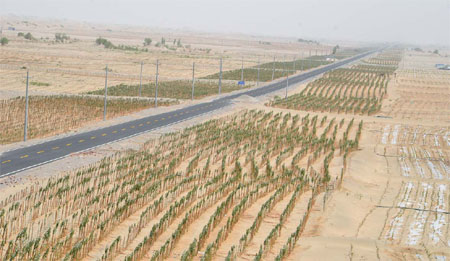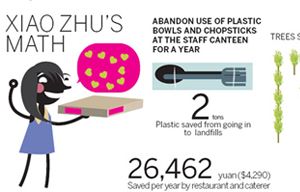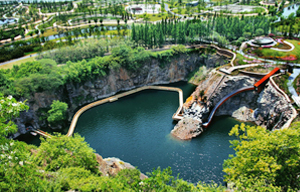Holding back the sands of time
|
A new artificial greenbelt in Hotan county in the Xinjiang Uygur autonomous region. Photos by Mao Weihua / China Daily |

Desert dwellers are slowly reclaiming cultivatable land, as Cui Jia and Mao Weihua report from Hotan, Xinjiang Uygur autonomous region.
Hotan prefecture in the southwest of the Xinjiang Uygur autonomous region is famous for two things: jade and sand. The locals still try to pluck the precious stones from the dry bed of the Yurungkash River, also known as the White Jade River, but the rising value of jade means the place has almost been picked clean after repeated treasure hunts, so the chances of making new discoveries are slim. However, in this area bordering the Taklimakan, the world's second-largest desert, the sand will never disappear.
Almost every one in Hotan lives close to the more than 300 oases, large and small, that are dotted around the southern edge of the Taklimakan. Those enclosed by the desert only account for 3.7 percent of Hotan's total area. As a result, people have to cope with windborne sand for more than 260 days a year. On a bad day, they have to be prepared to seek cover from sandstorms, which can blacken the sky within minutes and without warning. In addition to the health problems posed by the storms, sand carried at high speed can erode buildings and strip the paintwork from vehicles.
In Hotan, the transition between oases, fed by the floodwater from northern Hotan's Kunlun Mountains, and the desert is almost instantaneous. One minute the scenery along the road is pure yellow desert and the next, tall poplar trees on both sides of the road suddenly begin to provide comfortable shade from the searing heat.
"At the current rate, the prefecture has been losing 33 square kilometers of oases every year, due to the invasion of the Taklimakan and the construction of infrastructure. Meanwhile, the local population is booming, so we have no choice but to create about 66 sq km of oases every year," said Chen Baojun, Party chief of the prefecture's forestry bureau, who has 20 years experience in desertification control.
He said the sand from the Taklimakan can be carried as far away as Beijing and sometimes even as far as Japan, meaning control of desertification in Hotan has both a national and international resonance.
Qira county was once a kingdom on the ancient Silk Road in the days of the Eastern Han Dynasty (AD 25-220). The county seat has relocated north three times because the sands have eaten up the cultivatable land. The first relocation occurred more than 2,000 years ago and the most recent about 620 years ago.
In the 1980s, the county seat faced yet another relocation because the desert was only about 1.5 km away. Many locals were forced to move because their houses were buried under sand, often overnight.
It was at that point that the government stepped in to provide measures against desertification. In the days before the measures, the locals tried to prevent the sand from encroaching on their homes by erecting fences around the houses, said Chen.
Green Great Wall
In 1978, the central government launched the Green Great Wall project, aiming to create a chain of forests stretching from Xinjiang to north China's Heilongjiang province to prevent soil erosion and desertification. The project, one of the biggest artificial afforestation programs in the world, is ongoing and is expected to be completed in 2050.
For the people of Qira, preventing the sand from shifting is a matter of life and death. In Hotan, the desert has buried many ancient kingdoms, leaving the remains standing deep in the desert. Since the project was launched, a forest belt has been created and the desert has receded by more than 8 km.
Memet Simay's household was one of 446 in Qira township forced to relocate in the 1980s, although the family has since returned to the area.
"When I woke up one morning, I found I couldn't open the door because of the weight of sand that had accumulated overnight. My crops were buried too, so I had no choice but to move," he recalled.
He now grows dates in a field protected by a fence of poplar trees. Memet is responsible for looking after these "guardians", as he calls the poplars.
To remind people of the scale of desert encroachment, one large sand dune has been left in the township and has become a playground for the children.
"Growing things in the desert is not easy, and it's extremely expensive," said Qi Zhendong, director of the Qira county office of desertification prevention and control.
He was inspecting some cash crops, including dates and wolfberry trees, which are drought resistant. They were planted on the outskirts of the county last year to reduce the force of the wind-carrying sands blowing into Qira.
"If a sandstorm happened now, I wouldn't be able to see you," said Qi, standing only about 2 meters distant.
The average cost of the cash crop belt, about 5.7 km long and 100 meters wide, is about 10 yuan ($1.60) per sq m, although in some areas, the figure can reach 15 yuan.
This year, Qira county aims to build 9.3 sq km of new oases close to those that already exist. "Most of Qira's revenue is devoted to creating new oases alongside the roads the government built, digging wells and planting trees. Local people plant crops," said Qi. "We have never before put so much effort into creating new oases. We appreciate the financial support from the central government and the pairing-assistance provinces program over the past three years."
The "pairing-assistance" model, unveiled by the central government in 2010, requires 19 provinces and municipalities to support the development of Xinjiang through investment, provision of raw materials and working know how.
Experience has taught Chen of the forestry bureau that local people must be involved in, and benefit from, the program to prevent and control desertification. Without that crucial local input, the plants might easily die from a lack of attention.
"We have piloted a program of assigning care of plants and trees to local farmers. They put in the work of watering and taking care of them and when the plants are ripe, the locals can sell the produce. So they reap a financial benefit from the new oases, while Hotan benefits environmentally."
He said most of Hotan's seven counties have built new oases during the past couple of years.
Related:
Eco-toilet concept struggles for acceptance
| The green workplace | Digging deep to discover beauty |





















